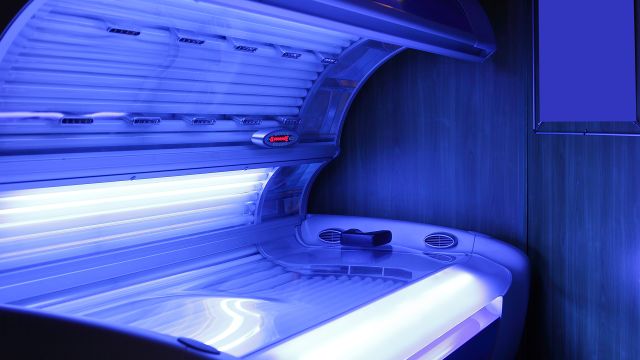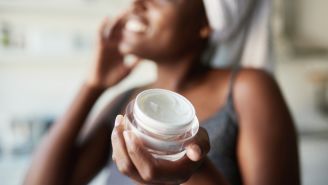Updated on February 11, 2025.
Indoor tanning is dangerous. From skin cancer to eye damage, it can lead to a wide range of serious health problems. And while the numbers are dropping, about 7.8 million adults in the United States still tan in salons, spas, and gyms, according to the American Academy of Dermatology (AAD).
So, how can indoor tanning affect your skin and your health overall? Are there safer ways to get a sunny glow? And how can you protect your skin from harmful ultra-violet (UV) rays, no matter their source?
Basics of indoor tanning
When a person tans outdoors, they simply lie in the sun. Indoor tanning involves the use of beds or booths. These devices are equipped with lamps that produce UV light in the form of UVA and/or UVB rays that act to darken skin. The sun emits these rays, as well.
If you’ve tanned indoors, your skin is primarily exposed to UVA rays. They tend to penetrate the skin deeper than UVB rays. But both can lead to health issues, including skin cancer.
There’s no such thing as a safe tan, whether it comes from exposure from UV light in a tanning bed or UV radiation from the sun. Although many people believe a “base tan” protects the skin from further damage, this is a misconception. The darkening of your skin is your body trying to protect itself by producing extra melanin. A tan is visible proof of skin damage.
Health risks of indoor tanning
Lying or standing in an enclosed space while being exposed to UV radiation is never safe. In fact, many states have various laws which aim to protect minors from these harmful rays. Why? Indoor tanning is dangerous and linked to many health risks.
Cancer
The World Health Organization considers tanning beds to be a carcinogen, a cancer-causing agent. Tanning indoors just once can significantly increase a person’s risk of melanoma, the deadliest form of skin cancer. Indoor tanning can also boost the chances of squamous cell carcinoma, which occurs on the top layer of skin, by 58 percent, according to the AAD. It raises the odds of basal cell carcinoma, the most common skin cancer, by 24 percent.
Premature aging
You’re more likely to develop wrinkles, dark spots, and skin that has lost its firmness due to indoor tanning.
Eye damage
Indoor tanning is known to cause eye damage in the form of cataracts, ocular melanoma, and macular degeneration, the leading cause of vision loss. Certain types of tanning lamps can also cause photokeratitis, which is often described as a “sunburn” of the cornea.
Immunity issues
Immune suppression, or the weakening of the body’s defenses, can be caused by overexposure to UV light. Indoor tanning may increase a person’s sensitivity to natural sunlight, reduce the effectiveness of vaccines, and even cause the body to react differently to medication.
Addiction
More than 20 percent of 18- to 30-year-old white women who tan indoors display signs of addiction, according to the AAD. They may find it difficult to stop the habit and even get fidgety or depressed when they don’t have a constant source of UV rays.
Other injuries and mishaps
Even the tanning beds and booths themselves aren’t always safe. They can lead to injuries that require emergency treatment, including burns and fainting.
Indoor tanning salons often give customers incorrect information about the dangers of the activity, too. They may claim tanning beds don’t post health risks, for example, or that they can provide health benefits.
Are there safe ways to get a sun-kissed glow?
For people who want to appear tanner, self-tanner is an option. It comes in the form of lotions, creams and even sprays that are applied to the skin. To use self-tanner, exfoliate your skin with a cloth. Once it’s completely dry, apply the lotion evenly in sections using circular movements. Make sure you’re completely dry before getting dressed.
Keep in mind that self-tanners do not protect you from the sun. The AAD recommends people still use sunscreen with an SPF of 30 or higher while outside, with broad spectrum protection that is also water-resistant. Reapply the sunscreen at least every two hours, especially if you are sweating or swimming. Aim for about a shot glass full of sunscreen to use on your entire body.
Since the sun is a source of vitamin D, some people may use indoor tanning to get their recommended daily amount of the nutrient. This isn’t safe. The ideal way to get enough is through the foods you eat. These include milk, fatty fish such as salmon and tuna, and foods fortified with vitamin D.
How to protect yourself from skin damage
If you tan indoors, the best thing to do is to quit immediately. If you’ve never tanned, don’t start. It could save your life.
Besides wearing sunscreen consistently, try these tips to help prevent skin damage and health issues stemming from UV rays:
- Limit sun exposure during the peak hours of 10 a.m. to 4 p.m.
- Wear clothing to protect your face, like a hat with a wide brim and sunglasses
- Get a skin exam from a dermatologist every year
Whether or not you tan, reach out to a healthcare provider (HCP) if see a suspicious spot on your skin. Take special note if the spot is new, has changed in shape or color, or is scaly, crusty, or bleeding.







